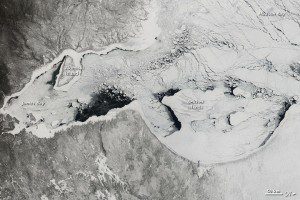
In early April 2012, snow blankets most of the land around this corner of Hudson Bay and sea ice coats the water in the bay. Click on image to enlarge.
NASA's Aqua satellite observed ice retreat in Hudson Bay, which typically begins in May and can melt out completely sometime in July. In the April 2012 image, abundant ice makes individual features difficult to distinguish. However, in the June 2012 image, Akimiski Island and the Belcher Islands seem to magically appear.

Two months later, snow has melted and ice has retreated, leaving Akimiski Island and the Belcher Islands easier to spot.
In early April 2012, snow blankets most of the land around this corner of the bay, and sea ice coats the water in the bay. The sea ice isn't a uniform sheet of frozen material. Instead, pieces of ice of varying sizes drift with winds and currents. Breaks in the ice allow glimpses of dark ocean water. Still, ice covers most of the water. Patches of open water in the southeastern corner of the bay owe their existence to winds pushing ice away from shore.
Two months later, snow has melted and ice has retreated, leaving Akimiski Island and the Belcher Islands easier to spot. The ice in Hudson Bay has taken on a bluish tinge, likely due to waterlogged ice and surface melt on the ice. Note that ice has moved into some areas”for instance south and west of the Belcher Islands, where it had not appeared in early April. The ice isn't spreading; it's simply moving and, broken into small pieces, it can drift easily. Unlike two months earlier, areas of open water result from melt.
Images courtesy of NASA.

